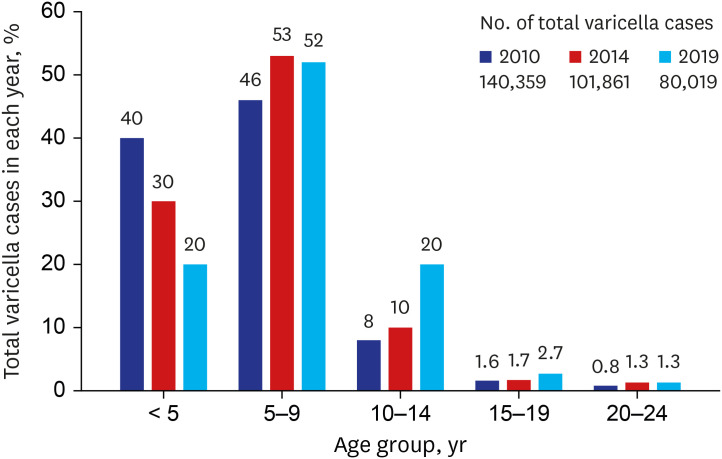J Korean Med Sci.
2021 Jul;36(27):e200. 10.3346/jkms.2021.36.e200.
Letter to the Editor: Effectiveness of the Varicella Vaccine in Korea: Unresolved Issues
- Affiliations
-
- 1Department of Research and Development, GC Pharma, Yongin, Korea
- 2Department of Medicine, University of California, Irvine, CA, USA
- 3Department of Pharmacovigilance, LSK Global PS, Seoul, Korea
- 4Department of Clinical and Regulatory Affairs, LG Chem Ltd, Seoul, Korea
- 5Department of Preventive Medicine, Wonju College of Medicine, Yonsei University, Wonju, Korea
- KMID: 2518357
- DOI: http://doi.org/10.3346/jkms.2021.36.e200
Figure
Cited by 1 articles
-
Letter to the Editor: Effectiveness of the Varicella Vaccine Among Korean Children: Suggestions for Future Research
BongKyoo Choi, Hyunjeong Cho, Younchul Shin, Eun-Kyoung Lee
J Korean Med Sci. 2021;37(1):e17. doi: 10.3346/jkms.2022.37.e17.
Reference
-
1. Lee YH, Choe YJ, Cho SI, Park HK, Bang JH, Lee JK. The author's response: effects of one-dose varicella vaccination on disease severity in children during outbreaks in Seoul, Korea. J Korean Med Sci. 2020; 35(28):e266. PMID: 32686378.
Article2. Choi B, Shin JH, Lee JE, Koh S. Letter to the editor: epidemiological comments on the effectiveness of the varicella vaccine in Korea. J Korean Med Sci. 2020; 35(28):e265. PMID: 32686377.3. Lee YH, Choe YJ, Cho SI, Kang CR, Bang JH, Oh MD, et al. Effectiveness of varicella vaccination program in preventing laboratory-confirmed cases in children in Seoul, Korea. J Korean Med Sci. 2016; 31(12):1897–1901. PMID: 27822926.
Article4. Guris D, Jumaan AO, Mascola L, Watson BM, Zhang JX, Chaves SS, et al. Changing varicella epidemiology in active surveillance sites--United States, 1995-2005. J Infect Dis. 2008; 197(Suppl 2):S71–S75. PMID: 18419413.
Article5. Lee YH, Choe YJ, Cho SI, Bang JH, Oh MD, Lee JK. Increasing varicella incidence rates among children in the Republic of Korea: an age-period-cohort analysis. Epidemiol Infect. 2019; 147:e245. PMID: 31364576.
Article6. Choi JK, Park SH, Park S, Choi SM, Kim SH, Lee DG, et al. Trends in varicella and herpes zoster epidemiology before and after the implementation of universal one-dose varicella vaccination over one decade in South Korea, 2003-2015. Hum Vaccin Immunother. 2019; 15(11):2554–2560. PMID: 31008679.
Article7. Choi EH. Effectiveness of Varicella Immunization in Korea. Cheongju, Korea: Korea Centers for Disease Control and Prevention;2017.
Article8. Black S, Ray P, Shinefield H, Saddier P, Nikas A. Lack of association between age at varicella vaccination and risk of breakthrough varicella, within the Northern California Kaiser Permanente Medical Care Program. J Infect Dis. 2008; 197(Suppl 2):S139–S142. PMID: 18419387.
Article9. Clements DA, Moreira SP, Coplan PM, Bland CL, Walter EB. Postlicensure study of varicella vaccine effectiveness in a day-care setting. Pediatr Infect Dis J. 1999; 18(12):1047–1050. PMID: 10608622.
- Full Text Links
- Actions
-
Cited
- CITED
-
- Close
- Share
- Similar articles
-
- Letter to the Editor: Effectiveness of the Varicella Vaccine Among Korean Children: Suggestions for Future Research
- Varicella Vaccine
- Update in varicella vaccination
- Letter to the Editor: Epidemiological Comments on the Effectiveness of the Varicella Vaccine in Korea
- Varicella vaccination: Worldwide status and p rovisional updated recommendation in Korea


